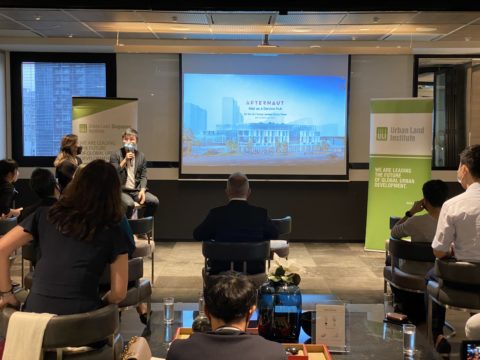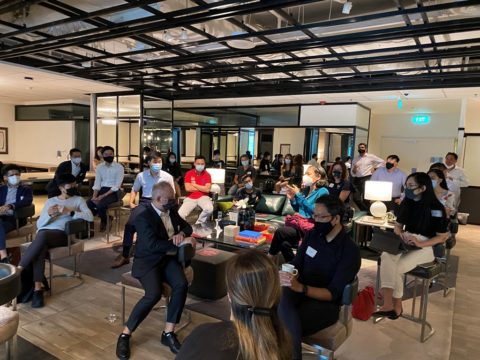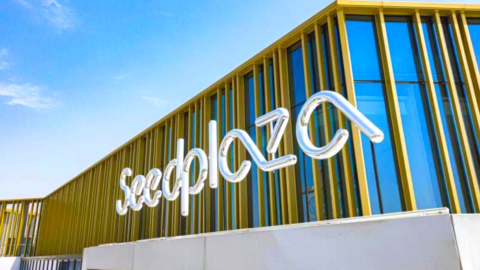Mall as a Service Hub
With the intention to introduce malls as service hubs, Afternaut’s Seedplaza project was conceptualised prior to the Covid-19 pandemic .
27 September 2021
Shi Hanyan
With the intention to introduce malls as service hubs, Afternaut’s Seedplaza project was conceptualised prior to the Covid-19 pandemic and successfully put into implementation across several Chinese cities since March 2021.

ULI Singapore’s Young Leaders Group (YLG) recently organised an in-person event inviting the Afternaut Group’s team to share their design conceptualisation process, and having audience debate about the feasibility of such model could work in Singapore.
Drawing from his own experience as a Singaporean who also has lived overseas as well as his expertise in retail sector, Mr Chew Kokyong, Co-Founder of the Afternaut Group suggested that it was consumerism that essentially defines retail.
“The speed retail is transforming is amazing”, said Chew. In China, the rapid advancement of technology and digitalisation of payment process and retail marketing created a generation of consumers who are always hungry for new content, which in turn catalyses the shift from service providers from the supply side.
Therefore, the team at Afternaut had to arrive at a decision of what exactly they were designing at the conceptualisation stage.
For retail 3.0… we made a decision to move from product to service. We started to look at the plaza (and wondering) why don’t we turn real estate into a service and implement it into a plaza. Such that in future iterations, everything can be enhanced without touching the physical infrastructure, but yet flexible enough to introduce new brands, for collaborations, for marketing, and for consumerism.
Chew Kokyong
Co-Founder, The Afternaut Group
Ms Gwen Tan, Design Principal at the Afternaut Group and Co-Founder of Formwerkz Architects, further added that the consumer end goal and how to create an engaging community-led space were always central to the designing process of this service-centric project.
Three conceptual pillars were incorporated into the design ideology of the service-centric Seedplaza – liveability, design-led tech-driven and collaboration.
For the liveability aspect, as Tan explained, the design team looked into what the space would mean through the lens of multigenerational families who are residing within the mall’s service radius. Referencing Maslow’s hierarchy of needs, Seedplaza was aimed at fulfilling a wide spectrum from basic needs to psychological wellbeing for all age groups.
The objective was then translated into the spatial integration of main features, such as supermarket, edutainment facilities, medical hub that cater to multigenerational needs and indoor playground within the public space.
The design-led tech-driven aspect of Seedplaza is reflected from the seamless drop-off point configuration and the use of atrium public space. To ease the uncomfortable waiting experience for visitors during peak winter, a greenhouse-alike structure is attached to the mall as drop-off point. The greenery also brings about a refreshing visual image on a bleak winter day.
For the atrium public space, instead of simply installing digital screens across the building, digital touchpoints were embedded in the floor plates. The public space was then transformed into an interactive playground for children, as well as a visual cue that integrates the whole mall.
Collaborations with brands and services are being forged for Seedplaza to tap on e-commerce ecosystem. As Afternaut envisioned the services within Seedplaza to be hyper-personalised and a one-stop hub for visitors, collaborating and integrating vendors’ digital service platforms can help to address the inconvenient user experience caused by fragmentation. The digital service platform provided by Seedplaza also can ease the potential learning curve for consumers by integrating itself into existing well-established digital ecosystem.
Such collaboration and integration will not only bring convenience to the consumers by complementing their e-commerce shopping experience, but also serves the function as a medium for vendors understand the target customer based better and curate products accordingly.

As their client has a real estate portfolio with diverse asset classes, the bigger vision for Seedplaza is to fit into a wider spectrum of residential, farm, commercial and industrial, said Chew. Instead of taking a traditional approach whereby the developer engages different consultants at different stages of development lifecycle, Afternaut is now with their client nurturing an iterative process throughout which they are involved in designing the typologies as well as subsequent operation and data collection.
When asked about the implementation of Seedplaza’s digital ecosystem and overcoming the issue of sensitivity around data sharing among vendors, Chew said: “The objective and identity of the mall must be very strong and sharp…We want to see life, we want to see activities; we want to hear the sounds of children.”
The presentation was followed by a debate among the audience on whether services-only malls are applicable in Singapore.
The affirmative team argued that the concept of service-oriented malls is far from foreign in Singapore (i.e. medical service cluster around Novena), and there are precedents of community centres integrating several essential services in the same location. In addition, as retail malls are relatively saturated, having services-only malls would introduce variety within local communities. With carefully curated features, such malls may cater well to Singaporean’s lifestyles.
The opposite team cautioned the pitfall of retail malls as tenant mix could be repetitive. Needs for services are finite. Without being able to create aspirational experience for the customers, a service-centric mall may find it difficult to attract people. Moreover, a pure service mall may not be financially feasible. Curating services requires more space, rental level would effectively drop and so would the value of the property. The synergy among different components and usages is more crucial.
Regardless of whether service-only malls would succeed in Singapore, one thing is certain as pointed out by the audience that retail is a concept and has been evolved to cater to people’s preference. As Covid-19 pandemic reshaping the retail landscape, more brilliant and exciting changes will take place around our daily environment.
ULI Singapore warmly thanks The Great Room for hosting this event.

Photo By The Afternaut Group
Don’t have an account? Sign up for a ULI guest account.